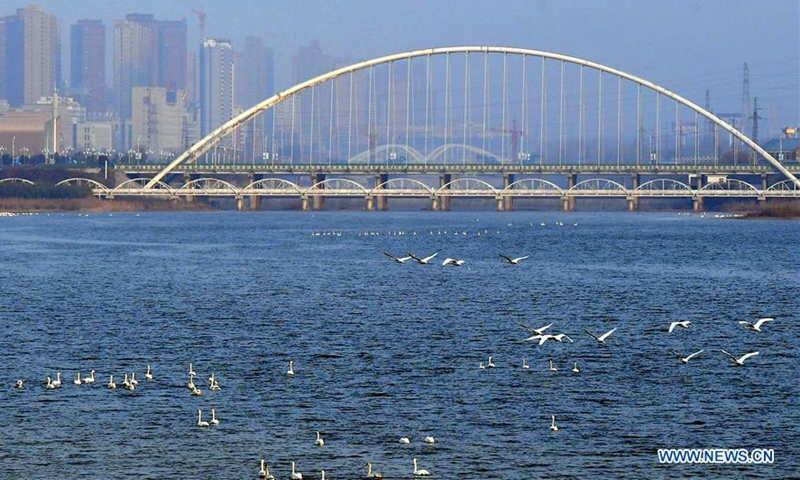Making Five-Year Plans: a scientific and democratic process
By Shan Jie, Huang Lanlan and Li Qiao Source: Global Times Published: 2020/10/29 20:58:40

Photo taken on Feb. 20, 2019 shows scenery of the Swan Lake national urban wetland park in Sanmenxia City, central China's Henan Province. China will not relax its ecological and environmental protection in the next five years, Minister of Ecology and Environment Huang Runqiu said on the sidelines of the annual session of the national legislature.
The process of making each Five-Year Plan has been fixed since late Chinese leader Deng Xiaoping's time, Su Wei, a professor at the Party School of the CPC Chongqing Municipal Committee, told the Global Times.
It could start three years ahead, with a lot of work on evaluation and research before a basic thinking is formed.
Based on the thinking, a draft proposal for the new 13th Five-Year Plan was made.
The draft proposal would be shared with national departments, local governments, non-Communist parties and relevant experts who would then give their feedback for modifications, according to Su.
Usually at the fifth plenary session of the CPC Central Committee, the proposal is decided upon and released afterwards. At the same time, the outline for the plan is drafted.
Then there will be processes including public suggestions, argumentation, and advice collection.
In the two sessions of the next year, the National People's Congress, China's top legislative body, deliberates on the outline draft and passes the final version of the plan. The new Five-Year Plan is usually published after the two sessions.
Zhu Lijia, a professor of public management at the Chinese Academy of Governance, noted that abundant research and investigation is undertaken during the creation of the plan, which is a democratic process with extensive consultations from grassroots representatives and involving input from thousands of think tanks, government agencies, universities, prominent scholars and professionals.
More than 1 million suggestions for the 14th Five-Year Plan were received from netizens, providing input for the decision-making process from August 16 to 29 this year, Xinhua reported.
China has made the Five-Year Plans to map out growth strategies for the country at different times through the decades. These plans were highly consistent with China's national conditions at each moment, as well as its internal and external environments, said Dai Yanjun, a professor with the Party School of the Central Committee of the CPC.
The First Five-Year Plan was made in 1953, when the newly founded People's Republic of China was eager to improve its backward industries and weak national economy after the Chinese People's Volunteers Army's participation in the War to Resist US Aggression and Aid Korea (1950-53). The development goals set in this plan - containing several hundred industrial construction projects of which some were supported by the then Soviet Union - were fulfilled ahead of schedule in 1957.
The accomplishment of the First Five-Year Plan's goals laid a foundation for China's industrialization and boosted rapid growth in the national economy, Dai said. "It made a good start for Chinese authorities to keep promoting development through goals in stages," he commented.
The 13th Five-Year Plan period (2016-20) is a "shift in China's growth strategies" which pays more attention to people's livelihood and social wellbeing apart from economic construction, said Zhu.
"It was a key point in the transformation of Chinese social development," Zhu said, adding that while the previous 12th Five-Year Plans focused more on economic growth, the 13th places more emphasis on environmental protection and poverty alleviation to address people's demand for a better life.
China has also embarked on a structural economic transformation from the 13th Five-Year Plan in the face of intensifying international competition, emphasizing the scientific and technological innovation to improve both the quality and efficiency of the economy.
Details in the plan vary at different times, but each plan is successive in nature and based on China's medium-to-long term goals being made at more macroscopic levels, Dai said, mentioning the goal of completing "the building of a moderately prosperous society in all respects" in 2020.
"The goal was firstly proposed by Deng Xiaoping at the end of 1980s," Dai said. "It is being achieved by the whole country through some 40 years of efforts by completing the detailed targets of each Five-Year Plan being set under the goal, such as the poverty alleviation target in the 13th Five-Year Plan period (2016-20)."
The future achievement of other medium-to-long term goals that Chinese authorities set out, such as "basically realizing socialist modernization by 2035" and "establishing a modern socialist country by 2050," will also depend on the accomplishment of their relevant periodic targets in the following Five-Year Plans, added Dai.
The development of China has been consistent and stable since the reform and opening-up, and a key is that "the country walks forward one step after another, one plan after another," Su said.
RELATED ARTICLES:
Posted in: IN-DEPTH